|
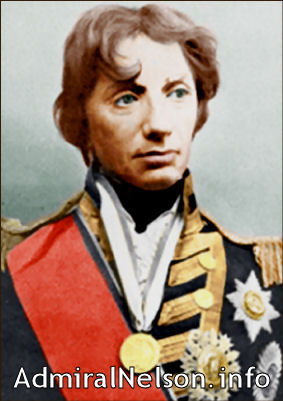












 Copyright Vicki Singleton 2013
Copyright Vicki Singleton 2013
|
|
|
Nelson's life and career in chronological order.
| |
1758 |
Horatio Nelson, known to his family and friends
as Horace, is born in Burnham Thorpe in Norfolk to the parson Edmund
Nelson and his wife, Catherine. |
|
| 1767 |
Nelson's mother dies. Horatio is just 9
years old. |
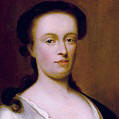
Catherine, Nelson's mother |
| 1771 |
January - Aged 12, Nelson
joins the Raisonnable, as
a midshipman, thanks to his uncle and captain of the ship, Maurice
Suckling
August - Travels to the West Indies in a merchant ship. |
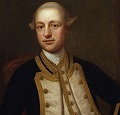
Captain Maurice Suckling |
| 1773 |
June - Aboard the
Carcass, Nelson joins an
expedition to the Arctic. Famously encounters a polar bear, but
the story of him fighting it is probably exaggerated.
October - Joins the
Seahorse and travels to the
East Indies. |

Carcass and Racehorse stuck in ice |
| 1776 |
March - Catches malaria and
returns to England to recuperate. |
|
| 1777 |
April - Nelson passes his
lieutenant's exam.
December -Joins the
Lowestoffe under Captain
William Locker, and heads to the West Indies. |
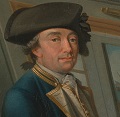
Capt. William Locker |
| 1778 |
September - Joins the
Bristol as first lieutenant.
December - Becomes commander of the
Badger brig. |
|
| 1779 |
June - Promoted to captain of
the Hinchinbrook. |
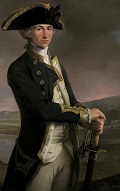
Capt. Nelson, 1781 |
| 1780 |
Leads the Nicaraguan expedition to capture the
Spanish Fort San Juan. But the expedition ends disastrously, with
almost the whole of Hinchinbrook's crew falling ill and dying.
Nelson himself nearly dies, and returns to England. |
| 1781 |
October - Takes command of the
frigate Albemarle. |
| 1782 |
Visits Quebec. Whilst there, he meets
Alexander Davison, who would become a life-long friend. He also
falls head over heels in love, but Davison persuades him from asking the
young lady to marry him. |
| 1783 |
The War of
American Independence ends.
Nelson returns to England. Later, he visits France with the
intention of learning the language. He falls in love and tries to
borrow money in order to finance a marriage. But, unsuccessful in
his endeavour, he returns to England. |
|
| 1784 |
March - Is appointed captain
of the Boreas and sails to the
West Indies. His task here is to suppress newly-illegal trade with
the Americans, but takes this duty so seriously that he almost lands
himself in trouble. This is probably one of the least successful
commands in his career. |

Boreas |
| 1785 |
May - Meets Frances Nisbet at
Nevis and begins courting her. |
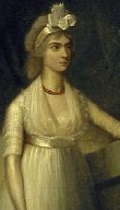
Nelson's wife, Frances |
| 1786 |
December - Appointed
aide-de-camp to Prince William Henry. Although this appointment
leads to some controversial decisions on Nelson's part, he and the
prince become good friends. |
| 1787 |
March 11th - Marries Frances
Nisbet.
December - Returns to England and lives with his wife
in Norfolk on half pay. But he longs to be back at sea and
frequently writes to the Admiralty to request a post.
Unfortunately, since the American war ended there are very few posts
available. |
| 1793 |
The French
Revolution begins
January - Nelson is given command of the 64-gun
Agamemnon. This would
prove to be one of his favourite commands, and many of Agamemnon's
crew would follow him to later ships.
June - Nelson is in the Mediterranean under overall
command of Admiral Lord Hood.
September - Meets Sir William and Lady Emma Hamilton at
Naples. |

Agamemnon |
| 1794 |
Takes part in the sieges of Corsica, Bastia and
Calvi.
July 12th - A shot sprays sand and stones into Nelson's
face. His right eye is irreparably damaged and he is left
partially blind for life. |
|
| 1795 |
March 12th - With Vice-Admiral
Hotham's fleet at the Battle of Genoa. Nelson helped to capture Ça
Ira.
July 7th - Agamemnon came
across the French fleet and was chased.
July 13th - Again under Vice-Admiral Hotham's fleet,
fought at the Battle of Hyères Islands. |
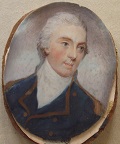
Vice-Admiral Hotham |
| 1796 |
March - Nelson is promoted to
commodore.
June - With the Agamemnon needing to return
home for repairs, Nelson asks for, and is granted, command of the 74-gun
Captain. He then assists
with the evacuation of Leghorn.
December - In the wake of the Spanish and French fleets
combining to form a superior force, Admiral Jervis sends Nelson, in the
frigate Minerve,
along with the Blanche, to evacuate British troops
from Porto-Ferrajo on the island of Elba. On the way there, they
defeat two Spanish frigates, but Nelson is forced to give up his prize
when more Spanish ships appear. |

Captain |
| 1797 |
 February
14th - The Battle of Cape St Vincent February
14th - The Battle of Cape St Vincent
Nelson distinguishes himself by wearing out of the line of
battle and bearing down on the Spanish fleet with just one other British
ship, the Culloden. He captures the Spanish San
Nicolas, personally leading the boarding party. Then, in a
unique move, he jumps from the San Nicolas to the San Josef
and captures that ship, too. The move was later nicknamed
'Nelson's patent bridge for boarding first rates'. Nelson
is injured by a large piece of debris striking his stomach. He
describes it as no more than a 'bruise', but in fact he suffered
internal injury that would trouble him for the rest of his life.
May 27th - Nelson is awarded Knight Companion of the
Order of the Bath, promoted to Rear-Admiral, and given command of the
Theseus.
July 24th - Nelson leads an attack on Santa Cruz,
Tenerife. It fails disastrously, after strong winds push his boats
back and the Spanish, alerted to the attack, fire heavily upon the
British. They suffer many losses, and Nelson is shot in his right
arm, above the elbow. The wound is so severe that he nearly dies
from loss of blood, but his life is saved by his stepson, Josiah Nisbet,
stemming the flow with a tourniquet. His arm is amputated almost
immediately. He returns to England and spends several long and painful
months recovering from the devastating injury. |
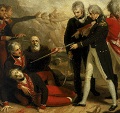
Nelson receiving the surrender of the San
Josef |
| 1798 |
March - Having recovered
somewhat and learnt to live without his arm, Nelson hoists his flag in
the Vanguard and
returns to the Mediterranean. Earl St Vincent gives him command of
a detached squadron.
July - Searches for Napoleon's fleet, but lack of
intelligence and frigates (which he calls the 'eyes of the fleet', and
the lack of which he complains of bitterly) to scout ahead, he
accidentally overtakes them and reaches Alexandria only to find the port
empty. He doubles back, and then back again, and finds the French
at the mouth of the Nile, anchored in Aboukir Bay.
1st August -
The Battle of the Nile
Wasting no time, Nelson orders an immediate attack, despite the fact
that night is approaching. Nelson's captains (his 'Band of
Brothers') manage to skilfully slip up the French line between the ships
and the shore, and fight at close range. The French are
annihilated, the flagship Orion blows up, and only two ships
escape. However, Nelson suffers a head wound which will plague him
with severe headaches for quite some time.
The battle earns Nelson the title of Baron Nelson of the Nile.
September - Arrives at Naples and stays with the
Hamiltons to recover from his injury. Controversially, he ends up
staying there for over year, involving himself in the politics of Naples
and famously beginning an affair with Emma, Lady Hamilton.
December 23rd - 26th - Nelson pushes for a Neapolitan
attack on Rome but, when it fails and the French counter attack, he has
to evacuate the royal family to Palermo.
|
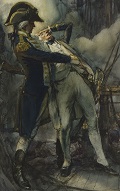
Captain Edward Berry catches Nelson
falling after being struck in the head by flying debris |
| 1799 |
January 23rd - the French
capture Naples.
June - Assists in the recapture of Naples but receives
criticism by the British for his handling of the situation, not least
because of his treatment of the rebels and the execution of Commodore
Carracciolo. Nevertheless, the King of Naples and Sicily gives him
the Dukedom of Bronte. For the rest of his life, Nelson will sign
his letters 'Nelson & Bronte'.
August - Nelson is made a Knight of the Ottoman Order
of the Crescent by the Turkish Sultan Selim III. |
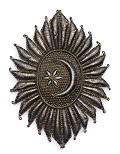
The Order of the Crescent |
| 1800 |
April - King Ferdinand awards
Nelson with the Knight Grand Cross of the Sicilian Order of St Ferdinand
and of Merit.
June - Returns overland to England with the Hamiltons,
and is greeted as a hero everywhere he goes. It becomes clear to
most people that he and Emma are in a relationship, and she is pregnant
with his child.
November 6th - Arrives at Great Yarmouth in England. |

Emma, Lady Hamilton |
| 1801 |
Nelson seems to believe that he can keep both
his wife and his mistress, despite his affair being a very public one.
Eventually, however, he separates from Frances.
January 1st - Nelson is promoted to Vice-Admiral.
January 13th - Hoists his flag in the San Josef,
the ship he captured at Cape St Vincent.
January 30th - Emma gives birth to the couple's
daughter, Horatia.
March 12th - Hoists his flag in the St George,
and joins the Baltic fleet as second in command under Admiral Hyde
Parker. Sub-ordination to Hyde Parker doesn't suit him, and he is
frustrated by his superior's cautiousness.
 April
2nd - The Battle of Copenhagen April
2nd - The Battle of Copenhagen
The battle is intended to force Denmark to leave the
Armed Neutrality of the Baltic states, which has been affecting British
trade. It is fought against a line at anchor, as at the Nile, but
this time the enemy fleet are defended by shore batteries. The
British fleet are split into two squadrons, and Nelson leads his into
close action while Hyde Parker's remain at a distance. During the
battle, Hyde Parker signals for Nelson to withdraw, a signal which
Nelson avoids by raising his telescope to his blind right eye and
declaring "I really do not see the signal!". The British are
eventually victorious, but Nelson describes it as the bloodiest battle
he has ever seen.
After the battle, Nelson plays a pivotal role in smoothing over
relations and talks with the Crown Prince of Denmark.
May 16th - Hyde Parker is recalled to England and
Nelson is made commander-in-chief of the Baltic fleet. But by this
time, he is feeling ill and wants to go home to his lover and daughter.
June - Nelson returns to England.
July 27th - Much to Nelson's annoyance, the Admiralty
promptly sends him to sea again, this time to oversee the anti-invasion
operations in the Channel. He doesn't think that the position
requires an officer of such high rank as a vice-admiral and begins to
suspect that the Admiralty want to keep him at sea to avoid the
embarrassment caused by his relationship with Emma when he was on shore.
But it's more likely that it was seen that his presence would boost the
morale of a nation increasingly afraid of an invasion by Bonaparte.
August 15th - Launches a boat attack against the French
invasion forces gathering at Boulogne. It ends disastrously and
results in the death of one of his favourite protegés, Edward
Parker, who he thought of as a son.
September - Emma finds a home for them at Merton Place,
situated between London and Portsmouth, and Nelson immediately buys it.
He is made a Knight Grand Commander of the Order of St Joachim.
October 1st - Britain and France sign
an armistice
October 22nd - Nelson returns to Merton.
|
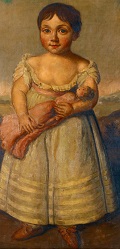
Horatia Nelson
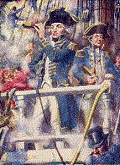
'Turning a blind eye' |
| 1802 |
March 28th -
Treaty of Amiens
April 26th - Nelson's father, Edmund, dies.
July - August - Nelson and the Hamiltons tour the
south-west of England, and the Midlands. Nelson is greeted with
adulation everywhere he goes.
|
|
| 1803 |
April 6th - Sir William
Hamilton dies, with Nelson and Emma both at his bedside.
May 16th - The Napoleonic War begins
May 18th - Having been appointed commander-in-chief of
the Mediterranean station, Nelson boards his new flagship,
Victory.
July 6th - Begins the blockade of the French at Toulon.
|
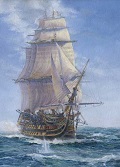
Victory |
| 1804 |
Continues the blockade throughout the year, and
forges diplomatic relations with other Mediterranean states. |
|
| 1805 |
April - July - The French
fleet escape from Toulon and join with the Spanish at Cadiz to form the
Combined Fleet of France and Spain. Nelson chases them to the West
Indies and back, protecting British trade in the process.
April 18th - Returns to Merton on leave.
September 14th - Boards Victory for the final
time. He sails to Cadiz to join Vice-Admiral Collingwood's fleet
there, which has been reinforced since Nelson left.
October 21st - Battle of Trafalgar
The Combined Fleet come out of Cadiz. Nelson issues the
'Nelson Touch' - his battle plan - to his captains. They sail in
two columns directly facing the enemy broadsides, and break through the
line in two places. Nelson flies his famous signal "England
expects that every man will do his duty" and then his final signal,
for close action. He trusts his captains implicitly, allowing them
to choose their own targets. Victory locks with the
French Redoutable and is very badly damaged, eventually unable
to be manoeuvred.
At about 12.30pm, Nelson is shot by a sniper in the Redoubtable's
mizzenmast. The single musket ball enters his left shoulder,
pierces a lung and an artery, and lodges in his spine. He is carried
below decks to the surgeon but nothing can be done. He lives for a
further three hours, long enough to know he secured a victory.
Upon hearing of the victory, he utters what were probably his last words
- "Thank God I have done my duty" - before passing peacefully away.
October 21st - 26th - William Beatty, the ship's
surgeon, preserves Nelson's body in a barrel lashed to Victory's
mast.
An incredibly violent storm strikes. Nelson, with his extended
knowledge of the weather patterns in the area, had predicted it, and had
issued orders for the fleet to anchor after the battle. But
Collingwod, upon assuming command after Nelson's death, chooses to ride
it out instead. The storm devastates the fleet and 14 ships are
lost. Only one ship had been lost during the battle itself.
It's possible that the outcome would have been very different had the
fleet anchored.
|
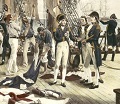
'England Expects'
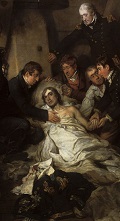
The Death of Nelson |
| 1806 |
January 9th - Nelson's
funeral. After laying in state in the Painted Hall in Greenwich, a
grand procession carries him up the Thames and then through the streets
to St Paul's Cathedral. He is interred in the crypt beneath the
cathedral in an ornate, multi-layered tomb comprising the coffin that
had been made for him out of the Orion's mast after the Battle
of the Nile, and a sarcophagus that had been made for Cardinal Wolsey
that Henry VIII had not allowed him to have. The tomb can be
visited to this day. Nelson's body is not in the fancy sarcophagus
perched on the top, but in the stone base. |
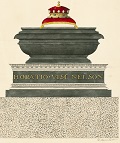
Nelson's tomb |

vicki@admiralnelson.info
|
|